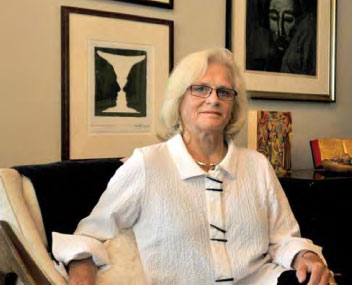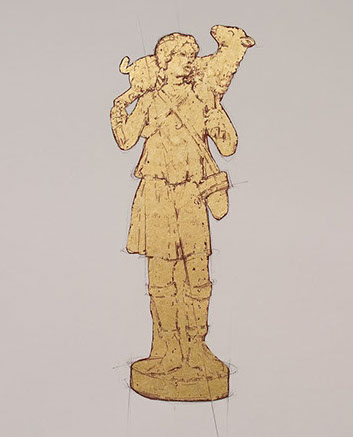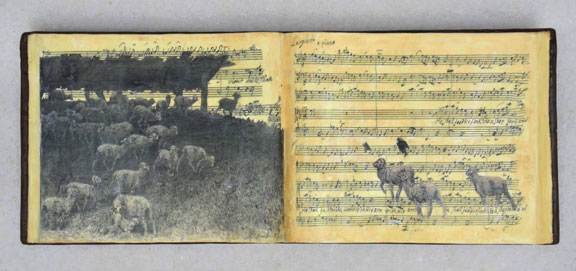

Sandra Bowden:
The Word in Art
BY HOPE FERGUSON
Spring 2014 | CONNECTIONS MAGAZINE
FOR SOMEONE WHO is known for connecting the transcendence
of faith with art, Sandra Bowden ‘77 seems surprisingly down to earth. A visit to her home in Chatham, Mass. on Cape Cod reveals a highly organized artist who runs her intersecting lives as a painter/printer, collector and curator with stunning efficiency. Her garage even doubles as a shipping center for sending her traveling shows out to museums, colleges and churches.
When we arrive, Sandra and her husband Robert both come out on the manicured lawn to greet us. It is a glorious June day; all bright sunshine, blue skies and salty ocean air; and Bowden, a slender, blonde, tailored woman in a black and white pants suit and geometric dangling earrings, is framed by a blazing pink Azelea bush; creating an apt first impression.
In The Art of Sandra Bowden, a retrospective book on her work, Bruce Herman, a gallery director at Gordon College, calls her a phenomenon. Her work hangs in the Cincinnati Museum, Billy Graham Center Museum, the Museum of Biblical Art, and the Vatican Museum of Contemporary Religious Art, among other places. She is a founder and past president of Christians in the Visual Arts, where she helped arrange shows and encouraged other Christian artists.
James Romaine, who edited the book, says she “may be one of the boldest artists of her generation … Most professional artists find their voice, some sooner than others, some stronger than others, and settle into a comfortable production of work … that can be a Faustian exchange for the safety and marketability that such limits bring. Sandra Bowden never made that deal. Instead, she has plunged herself into exploring systems and limits of vocabulary and language itself.”
While most of her pieces – highly textured, glowing, tactile – could be described as abstract, they also seem at the same time ancient and familiar, and, like her series of book art, immediately relatable.
Always a Christian
Bowden came of age in a plain-spoken New Hampshire church built by her forebears. She didn’t know people who didn’t go to church and love the scriptures, she says. There was never a time she didn’t identify as a Christian.
The contemporary home she shares in Chatham with her husband (the two also have another home in South Carolina), a former beekeeper (this was just a hobby), whom she met at youth camp when she was just 15, serves as an exhibit space for the various styles and periods of her art. Those styles include gold leaf “books,” with raised Hebrew and Greek lettering, collagraphs – a type of printmaking technique in which materials like fabric and string are glued onto a masonite plate to form images in relief; iconic crosses covered in gold from photos that she later modifies; music notations using actual pages of music; prints based on illuminated book pages, crucifixions and a series of geographical prints of natural wonders such as the Grand Canyon.
Early Talent
In the spring 1961, Bowden, who had taken first prize in an art contest in high school, was asked to contribute a piece to the Beverly Baptist religious art show. “You like it?” she asks, motioning to the artwork called “Ancient Writing,” before saying that she hadn’t a clue that it would point to what would become a signature style. It is “just a suggestion of writing fragments on burlap,” using gesso modeling paste. The writing wasn’t real – that would come later, with the implementation of Hebrew and later Greek letters in her pieces. “But something just gelled inside of me,” she says.
Beginning of a Motif
In 1978, she did a series exploring creation with lettering suggestive of Hebrew text. A Jewish man she knew from Glens Falls suggested that she begin to study Hebrew and use real Hebrew lettering. “We have writing that is 3- 4,000 years old by which we share thoughts of another person across time and place. It’s this religious text that God chose to communicate with us through,” she says.
Completed in 1978 “In the Beginning,” a moody piece using a dark palette uses real Hebrew letters illuminated from the top by a white light, suggesting, as per Genesis, “the spirit of the Lord brooding over the waters.”
Then there is the series of artist’s books that act as boxes, using Biblical text to illustrate such things as the pearl of great price (a small box filled with real pearls) and “Even the Stones”, a gold-leaf covered box full of stones; and a book with nails glued on the cover. Her series of crucifixion portraits of Christ likewise employ real nails. “The Art of Sandra Bowden,” tells the story of a bereaved woman whose brother had died in an accident, who wrote to let Bowden know what comfort one of those paintings had given her.
“Until 1994, I did collagraphs,” Bowden says. “In ’94 I had back surgery, so for months couldn’t do anything, so I cut up a print” tossed in some gold leaf, and thereby birthed the Collage series. “Each one of the series had its own birth,” she explains. “Same with the Illuminations series, which arose from an invitation from Emma Willard School to produce something for a show.”
Giving the Japanese artist Sadao Watanaba more exposure has been a recent passion. He became a Christian at age 17 after a missionary invited him to church. His father had died and he contracted tuberculosis. Needing to support his family, he pledged that if the missionary prayed for him and he became better, he would accept Christ. The colorful, folkloric works of Watanaba comprise a traveling show as well as an exhibition book sponsored by Christians in the Visual Arts commemorating the 100th anniversary of his birth.
When asked whether she considers herself a “Christian” artist, Bowden told an interviewer that the exact terminology to describe her art doesn’t matter to her. “My art is a visual record of my spiritual and artistic journey. Each work that I do seems to beg another question and then leads me to the next work. My job has been to ‘follow the work’. Early on, my work was very abstract, only alluding to a vague theme. But over the course of time I have come to realize that my work focuses on the WORD, both the written word and the Word made Flesh.”

® 2025 | ALL RIGHTS RESERVED | design by www.isleydesign.com